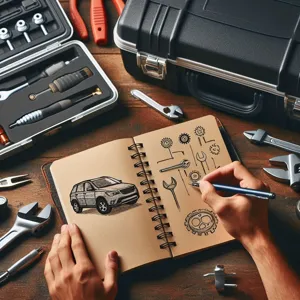Owning a vehicle is not just about the thrill of the open road; it also comes with the responsibility of ensuring that it runs smoothly and safely for years to come.
One of the most crucial yet often overlooked aspects of car ownership is keeping meticulous maintenance records. A well-organized record system can not only prolong the life of your vehicle but also save you from unexpected breakdowns and costly repairs. In this comprehensive guide, we’ll explore the essential steps to mastering your car’s care through effective maintenance record organization. From creating a dedicated space for your documents to utilizing digital tools that streamline tracking, we’ll provide you with practical tips and strategies to ensure you’re always in the know about your vehicle’s history and needs. Whether you’re a seasoned car enthusiast or a first-time owner, this guide will equip you with the knowledge to keep your car in top shape and give you peace of mind every time you hit the road.
1. Introduction: The Importance of Keeping Maintenance Records

Keeping detailed maintenance records for your car is not just a good practice; it’s an essential part of responsible vehicle ownership. Imagine this: you’re at a dealership, discussing your car’s trade-in value or preparing for a major repair. The mechanic asks for your maintenance history, and you find yourself scrambling to recall when you last changed the oil or rotated the tires. Without a clear record, you risk undervaluing your investment or, worse yet, jeopardizing your vehicle’s performance and longevity.
Maintenance records serve as a comprehensive log of every service, repair, and inspection your car undergoes. They not only help you stay organized but also enhance your vehicle’s resale value. A well-documented history demonstrates to potential buyers that you’ve been diligent in caring for the car, which can lead to a higher selling price. Furthermore, by tracking maintenance schedules, you can anticipate necessary services and avoid costly emergencies.
In an age where we increasingly rely on technology, keeping digital and physical records has never been easier. From simple spreadsheets to dedicated car maintenance apps, there are numerous tools available to help you keep track of your car’s health. Ultimately, maintaining accurate records not only simplifies your life but also fosters a deeper understanding of your vehicle’s needs, ensuring you can enjoy many miles of worry-free driving. So let’s dive into the hows and whys of effective maintenance record-keeping and transform that chaotic jumble of receipts and fading memory into a streamlined system that works for you.
2. Why Organizing Maintenance Records Matters for Your Vehicle
Keeping your car in peak condition requires more than just regular oil changes and tire rotations; it demands meticulous attention to detail, especially when it comes to organizing maintenance records. But why does this seemingly simple task matter so much for your vehicle? The answer lies in the myriad benefits that come with maintaining accurate and accessible records.
First and foremost, organized maintenance records serve as a comprehensive history of your vehicle’s service life. When you keep track of all repairs and maintenance, you can easily review what has been done over time. This is invaluable when troubleshooting issues, as it allows you to pinpoint recurring problems or identify patterns that may indicate a deeper issue. For instance, if your brakes have been serviced multiple times in a short period, this could signal a more serious underlying problem that needs to be addressed before it escalates.
Moreover, having well-organized records can significantly boost the resale value of your car. Prospective buyers are often wary of vehicles with murky histories. When you can present a clear and thorough account of all maintenance performed, it instills confidence in potential buyers and demonstrates that you’ve taken proper care of the car. This transparency can be a deciding factor in negotiations, often allowing you to command a higher price.
Another crucial aspect is compliance with warranty requirements. Many vehicle warranties stipulate that specific maintenance tasks must be performed at regular intervals. By keeping detailed records, you can prove that you’ve adhered to these guidelines, ensuring that your warranty remains valid. This can save you a substantial amount of money should you need to make a claim.
Lastly, organizing maintenance records can save you time and stress. Instead of scrambling to find receipts, invoices, or service records when it’s time for an inspection, you’ll have everything at your fingertips. Whether you prefer a digital solution or a traditional binder, having a system in place allows you to focus on what truly matters—enjoying the open road with peace of mind, knowing your vehicle is in top shape.
In summary, keeping your maintenance records organized is not merely an administrative task; it’s a proactive approach to vehicle ownership that enhances performance, increases resale value, ensures warranty compliance, and simplifies the car care process. By prioritizing this essential aspect of vehicle management, you can drive with confidence, knowing that you’re taking every possible step to preserve the longevity and reliability of your car.
3. Types of Maintenance Records to Keep

When it comes to mastering your car’s care, one of the most vital steps is understanding the various types of maintenance records you should keep. Well-organized records not only help you track your vehicle’s history but also play a crucial role when it’s time to sell or trade-in your car. Here are some essential types of maintenance records to consider:
1. **Routine Maintenance Logs**: These include records of regular services such as oil changes, tire rotations, and fluid checks. Keep track of the dates, mileage, and service providers. This will not only help you stay on schedule for future maintenance but also provide potential buyers with proof of diligent care.
2. **Repair Documents**: Every time your car requires repair—be it a minor fix or a major overhaul—document it. Include invoices, receipts, and detailed descriptions of the repairs conducted. This transparency builds trust with potential buyers and can also be beneficial if you encounter similar issues in the future.
3. **Warranty Information**: Keep a dedicated section for warranty documents, including details about what is covered, expiration dates, and contact information for the warranty provider. This can save you money on potential repairs while ensuring you are aware of your rights and responsibilities as a car owner.
4. **Recall Notices**: Stay informed about any recalls that may affect your vehicle. Keep copies of any notifications you receive, along with records of any repairs or replacements made as a result. This information is critical for safety and compliance, as well as for potential resale value.
5. **Inspection Records**: Document your vehicle’s inspection history, including emissions tests, safety inspections, and any certifications. These records can provide a clear picture of your car’s condition over time and demonstrate its compliance with local regulations.
By maintaining these types of records, you’ll create a comprehensive history of your vehicle that showcases its reliability and your commitment to its care. Not only will this organization facilitate smoother maintenance in the future, but it will also empower you with the knowledge and documentation needed to maximize your investment in your vehicle.
4. Choosing the Right Format: Digital vs. Physical Records
When it comes to maintaining your car, having organized maintenance records is essential for tracking repairs, warranties, and service schedules. But one crucial decision you’ll need to make in this process is whether to opt for digital or physical records. Each format has its own set of advantages, and understanding these can help you choose the best approach for your needs.
**Digital Records**: In our increasingly tech-savvy world, digital records offer unparalleled convenience. You can store all your maintenance information in one accessible location, whether it’s an app designed specifically for vehicle management or a simple spreadsheet on your computer. Digital records are easy to update—just a few clicks, and you can add a new oil change or record a tire rotation. Furthermore, many digital tools offer reminders for upcoming maintenance, ensuring you never miss an important service. The ability to back up your records in the cloud also means you won’t lose valuable information if something were to happen to your device.
**Physical Records**: On the other hand, there’s something to be said for the tactile nature of physical records. A dedicated binder or folder can give you a clear, organized view of your car’s history at a glance. This can be particularly useful when you’re at the mechanic’s office or if you’re looking to sell your vehicle and want to present a thorough maintenance history to potential buyers. Plus, having printed copies of receipts, warranties, and service records can help avoid the hassle of searching through digital files, especially if you’re not as comfortable with technology.
Ultimately, the choice between digital and physical records depends on your personal preference and lifestyle. Some car owners even find a hybrid approach works best—keeping essential documents digitally while maintaining a physical binder for key receipts and warranties. Whichever format you choose, the important thing is to stay consistent and committed to keeping your records organized. This will not only extend the life of your vehicle but also enhance its resale value down the road.
5. Essential Information to Include in Your Maintenance Log

When it comes to organizing your car’s maintenance records, having a comprehensive maintenance log is crucial for tracking your vehicle’s health and ensuring its longevity. This log serves as a valuable resource, not just for you, but also for future owners or mechanics who may work on your vehicle. Here are the essential pieces of information you should include in your maintenance log to keep everything in one organized place:
1. **Date of Service**: Always start with the date of each maintenance or repair. This helps you keep track of when specific services were performed and can alert you when it’s time for the next one.
2. **Type of Service**: Clearly note the type of service performed—whether it was an oil change, tire rotation, brake inspection, or a more extensive repair like a transmission overhaul. This detail helps you identify patterns in your car’s needs over time.
3. **Mileage at Service**: Recording the odometer reading at the time of service provides insight into how often maintenance is required relative to the distance driven. This is particularly useful for understanding if your maintenance intervals are optimal for your driving habits.
4. **Parts Replaced**: If any parts were replaced during servicing, document them along with the part numbers and any warranties associated with the replacements. This information is invaluable for tracking the lifespan of components and could save you time and money in the future.
5. **Service Provider Information**: Include the name and contact details of the mechanic or service center that performed the work. If you ever need to follow up on warranty issues or inquire about the service, having this information handy will simplify the process.
6. **Cost of Service**: Keeping a record of what you spent can help you manage your budget and prepare for future expenditures. It also allows you to identify any recurring issues that may be costing you more than expected.
7. **Notes on Performance**: If you noticed any changes in your car’s performance or any unusual sounds or behaviors, jot those down. This information can be crucial for diagnosing future problems and can help your mechanic understand the context of the service.
8. **Next Service Due**: Finally, it’s wise to include reminders for when the next maintenance is due, whether it’s based on time or mileage. This proactive approach ensures that you stay ahead of any potential issues and keep your car in optimal condition.
By including this essential information in your maintenance log, you create a detailed history of your vehicle’s care that not only keeps you informed but also enhances its resale value. A well-documented maintenance record signals to potential buyers that your car has been properly cared for, making it a more attractive purchase. Plus, this organized approach simplifies your life, allowing you to focus on enjoying the drive rather than worrying about what’s next on the maintenance checklist.
6. Creating a Maintenance Schedule: How Often to Service Your Car
Creating a maintenance schedule is a fundamental aspect of car care that can significantly prolong the life of your vehicle and enhance its performance. Knowing how often to service your car depends on several factors, including the make and model of your vehicle, your driving habits, and the conditions in which you typically drive.
Most manufacturers provide a recommended maintenance schedule in the owner’s manual, outlining specific intervals for oil changes, tire rotations, brake inspections, and other essential services. Generally, a good rule of thumb is to have your car serviced every 5,000 to 7,500 miles for oil changes, but this can vary based on whether you use synthetic oil or traditional oil.
Additionally, consider your driving habits—if you frequently drive in stop-and-go traffic, tow heavy loads, or navigate rugged terrain, you may need to service your car more often. On the other hand, if you primarily drive on the highway and maintain a consistent speed, your vehicle might require less frequent check-ups.
To keep things organized, create a maintenance calendar that marks the dates when each service is due. You can use a digital calendar, a dedicated app, or even a simple spreadsheet. Be sure to set reminders a week in advance to ensure you never miss a service appointment. Incorporating seasonal checks, such as preparing your car for winter or summer, can also be beneficial. Checking the fluid levels, inspecting the brakes, and ensuring your tires are in good condition will help you tackle any weather-related challenges.
By establishing a clear maintenance schedule, you not only protect your investment but also cultivate a proactive approach to car care, ensuring your vehicle remains reliable and safe for years to come.
7. Utilizing Apps and Tools for Record Keeping

In today’s fast-paced digital world, keeping your car maintenance records organized has never been easier, thanks to a myriad of apps and tools designed specifically for this purpose. Gone are the days of sifting through crumpled receipts and dusty notebooks; now, you can have all your important information at your fingertips.
Consider using dedicated car maintenance apps like Car Minder, MyCarFax, or Fuelly, which not only allow you to log repairs and service dates but also send reminders when it’s time for your next oil change or tire rotation. These apps often have user-friendly interfaces that make it easy to input data, upload photos of receipts, and even track fuel economy. With just a few taps, you can access your entire vehicle history, which can be incredibly valuable if you ever decide to sell your car or if you need to reference past services for troubleshooting.
If apps aren’t your thing, online spreadsheets like Google Sheets or Excel can also serve as an excellent alternative. You can customize your spreadsheet to include all relevant details such as date of service, type of service performed, mileage, and costs. Plus, with cloud storage, your records will be accessible from anywhere, anytime. This flexibility ensures that you’ll have your maintenance history handy whether you’re at home, at a mechanic, or even on a road trip.
For those who prefer a tactile approach, don’t overlook the power of a well-organized binder or folder. Use dividers to categorize sections for routine maintenance, repairs, and warranty documents. Include pockets for receipts and business cards, and you’ll create a physical record that’s easy to navigate.
Whichever method you choose, the key is consistency. Regularly updating your records not only helps in tracking your car’s health but also gives you peace of mind. By utilizing modern apps and tools—or even classic methods—you’ll be well on your way to mastering your car’s care and ensuring that no maintenance detail slips through the cracks.
8. Tips for Storing Receipts and Invoices
Keeping your car in top shape requires not only regular maintenance but also meticulous record-keeping. One of the most critical aspects of managing your vehicle’s care is properly storing receipts and invoices related to repairs, services, and parts. Here are some practical tips to help you organize these important documents effectively.
First and foremost, designate a specific folder or binder solely for your car’s maintenance records. This could be a physical folder kept in your glove compartment or a dedicated section in your home office. For digital enthusiasts, consider using a cloud storage service or a simple file organization system on your computer. This way, you can easily access your documents whenever you need them, whether it’s for a routine check-up or when you’re ready to sell your vehicle.
When it comes to sorting your receipts, consider organizing them chronologically or categorically. You might want to separate documents by type, such as routine maintenance (oil changes, tire rotations), repairs (engine work, brake replacements), or parts purchased (batteries, filters). Using labeled dividers can make this process even smoother, allowing you to quickly find what you’re looking for.
It’s also essential to keep these documents legible and intact. For physical receipts, use acid-free folders or plastic sleeves to protect them from fading or tearing. If you go the digital route, scan your receipts at a high resolution and save them as PDF files, ensuring they are easy to read and well-organized.
Lastly, don’t forget to regularly update your records. After each visit to the mechanic or after a DIY repair, promptly file your new receipts to keep your records current. This practice not only helps you track your car’s maintenance history but also increases the vehicle’s resale value, as prospective buyers appreciate detailed maintenance documentation.
By following these tips for storing receipts and invoices, you’ll cultivate a comprehensive maintenance record that supports the longevity and reliability of your vehicle while simplifying your life as a car owner.
9. How to Track Warranty and Service Contracts
Tracking your car’s warranty and service contracts is crucial for ensuring you get the most out of your vehicle’s coverage and maintaining its value over time. Start by gathering all of your documents in one central location—this could be a dedicated folder, a digital storage solution, or an app designed for car maintenance records. Having everything organized will save you time and stress when you need to access these documents.
Begin with your warranty information, which typically covers manufacturer defects and guarantees certain repairs for a set period. Document the terms of the warranty, including start and end dates, coverage details, and any specific maintenance requirements that must be met to keep the warranty valid. Be sure to note any contact information for the dealership or manufacturer, should you need to make a claim or ask questions.
Next, keep records of any service contracts you have purchased, such as extended warranties or prepaid maintenance plans. Record the details of these agreements, including what they cover, how long they last, and any deductibles or limitations. This information is invaluable when you need to decide whether to utilize these services for repairs or maintenance.
Regularly update your records with any service or repair work performed on your vehicle. This can include oil changes, tire rotations, brake inspections, and anything else that might impact your warranty. Keeping a detailed log not only helps you stay compliant with warranty requirements but also provides you with a history of your car’s care, which can be beneficial when it comes time to sell or trade in your vehicle.
To further streamline the process, consider utilizing a digital maintenance tracker or mobile app. Many of these tools allow you to upload images of your documents, set reminders for upcoming services, and receive alerts for warranty expiration dates. By taking these proactive steps, you’ll ensure that you are always informed about your vehicle’s warranty and service contracts, ultimately leading to better care and longevity for your car.
10. Organizing Records by Categories: Routine Maintenance, Repairs, and Upgrades
When it comes to mastering your car’s care, organizing your maintenance records is a critical step that can save you time, money, and headaches in the long run. One effective method is to categorize your records into three main groups: Routine Maintenance, Repairs, and Upgrades. This structured approach not only streamlines your documentation but also allows you to quickly access important information when needed.
**Routine Maintenance** is the backbone of your vehicle’s longevity. This category should include records of regular oil changes, tire rotations, fluid checks, and other scheduled services recommended by your car’s manufacturer. By keeping track of these services, you can easily monitor when the next maintenance is due, helping you stay on top of essential tasks that prevent more significant issues down the road. Consider using a dedicated folder or digital app to log dates, mileage, and service details, ensuring everything is in one accessible location.
Next, **Repairs** encompass any unexpected issues that arise and require immediate attention. This may involve anything from fixing a flat tire to replacing a faulty transmission. Keeping detailed records of repairs is crucial not only for your own awareness but also for future resale value. Potential buyers appreciate transparency, and having documented proof of repairs can build trust. Document the date, nature of the repair, parts used, and the shop that completed the work, providing a comprehensive history that enhances your vehicle’s resale appeal.
Lastly, **Upgrades** can significantly enhance the performance and aesthetics of your car. Whether you’ve installed a new sound system, upgraded to performance tires, or made modifications to improve fuel efficiency, documenting these changes is essential. Keep receipts, installation dates, and any warranty information associated with the upgrades. This not only helps you track your investment but can also be a selling point if you decide to trade in or sell your vehicle.
By organizing your vehicle’s maintenance records into these three categories, you create a clear and concise history of your car’s care. This proactive approach not only fosters good vehicle health but also empowers you with knowledge that can save you from costly repairs and help maintain your car’s value over time.
11. How to Create a Maintenance History Timeline
Creating a maintenance history timeline for your car is not just a smart organizational move; it’s an essential strategy for prolonging the life of your vehicle and enhancing its resale value. A well-structured timeline can help you track when specific services were performed, identify patterns in your car’s performance, and ensure that no important maintenance tasks are overlooked.
To get started, gather all your existing maintenance records, including receipts, invoices, and notes from previous service visits. If you’re missing some documents, don’t hesitate to reach out to your mechanic or dealership; many can provide copies of past services.
Next, decide on the format that works best for you. A simple spreadsheet can be an effective way to compile your data, allowing you to sort it easily by date, service type, or mileage. Alternatively, if you prefer a more visual approach, consider creating a timeline graphic that highlights major milestones, such as oil changes, tire rotations, and brake inspections.
In your timeline, be sure to include the date of each service, the mileage at the time, and a brief description of the work done. You might also want to note any recommendations or observations from your mechanic, which can be invaluable for planning future maintenance.
For added convenience, set reminders for upcoming services based on the intervals suggested in your owner’s manual or by your mechanic. This proactive approach will help you stay ahead of any potential issues, ensuring that your car remains in peak condition.
Finally, review and update your maintenance history timeline regularly. By keeping this document current, you’ll not only have a comprehensive record of your car’s care but also empower yourself with the knowledge needed to make informed decisions about its maintenance in the future. With a well-organized maintenance history timeline, you’ll be on your way to mastering your car’s care like a pro!
12. Regular Checklists for Different Seasons
Regular checklists for different seasons are essential for keeping your car in peak condition year-round. As the weather shifts, so do the demands on your vehicle. By creating tailored maintenance checklists for each season, you can proactively address potential issues before they escalate, ensuring your car remains safe and efficient.
**Spring Checklist:** As winter melts away, it’s time to inspect your vehicle for any damage caused by harsh conditions. Start by checking your tires for wear and tear, especially if they’ve endured icy roads. Ensure your windshield wipers are functioning well, as spring showers can arrive unexpectedly. A thorough wash and wax will not only keep your car looking sharp but also protect the paint from pollen and debris. Finally, consider an oil change if you’re due, as this will help your engine run smoothly in the warmer months.
**Summer Checklist:** With the heat of summer comes the risk of overheating. Check your coolant levels and inspect the radiator for any leaks. Ensure your air conditioning is running efficiently, providing comfort during those sweltering days. It’s also a great time to review your tire pressure, as hot pavement can cause tires to lose air more quickly. Don’t forget to examine your battery, as extreme heat can lead to diminished performance.
**Fall Checklist:** As leaves begin to fall, it’s crucial to prepare for the cold months ahead. Inspect your brakes and replace any worn-out pads to ensure safety on slick roads. Check your heating system and defrosters to make sure you’re ready for chilly mornings. This is also the ideal time to switch to winter tires if you live in an area that experiences snow. Lastly, clean out your trunk and glove compartment, ensuring you have essentials like an emergency kit and ice scraper handy.
**Winter Checklist:** As temperatures drop, your car needs special attention. Start by checking battery health, as cold weather can significantly impact performance. Inspect your antifreeze levels and ensure your windshield washer fluid is rated for low temperatures. Don’t forget to examine your tires for tread depth; consider using winter tires if you frequently navigate snowy or icy roads. Regularly clear snow and ice from your car to maintain visibility and avoid damage to your paint.
By keeping these seasonal checklists handy and organizing your maintenance records accordingly, you can streamline your car care routine. Not only will this help you stay on top of necessary upkeep, but it will also enhance your vehicle’s longevity and performance, allowing you to enjoy every drive with peace of mind.
13. The Benefits of Regularly Reviewing Your Maintenance Records
Regularly reviewing your maintenance records is one of the simplest yet most effective ways to ensure the longevity and reliability of your vehicle. Just as a doctor reviews your medical history before prescribing treatment, reviewing your car’s records provides crucial insights into its performance and condition. This practice can help you identify patterns or recurring issues, allowing you to address potential problems before they escalate into costly repairs.
One of the primary benefits of keeping a close eye on your maintenance records is the ability to track your vehicle’s service history. This includes everything from oil changes and tire rotations to more significant repairs and part replacements. By having a clear timeline of when services were performed, you can better assess when future maintenance is due, ensuring that your car remains in peak condition. For instance, if you notice that your brakes tend to wear out every 20,000 miles, you can proactively check their condition around that mileage, rather than waiting until you hear that dreaded grinding noise.
Moreover, reviewing your maintenance records can enhance your vehicle’s resale value. Prospective buyers are often keen to see a detailed history of how well the car has been cared for. A well-documented record not only demonstrates that you took diligent care of the vehicle but also reassures buyers that it is less likely to encounter major issues down the line. This transparency can make your car more attractive and can even help you command a higher price in the marketplace.
Lastly, regularly revisiting these records can keep you informed about any warranties or service agreements that may still be in effect. Understanding what is covered can save you money on repairs and provide peace of mind knowing that you’re getting the most out of your investments.
In conclusion, routinely reviewing your maintenance records is not merely a chore but a vital step in responsible car ownership. It empowers you to make informed decisions, prevents unnecessary expenses, and ultimately ensures that your vehicle remains a reliable companion on all your journeys.
14. Conclusion: Staying Ahead of Vehicle Issues Through Organization
In conclusion, mastering your car’s care begins with a commitment to organization. Keeping meticulous maintenance records is not just about ticking boxes; it’s about empowering yourself as a vehicle owner. As you maintain a detailed log of services performed, repairs made, and parts replaced, you create a comprehensive history of your car’s journey. This record not only helps you keep track of upcoming maintenance needs but also serves as a vital tool for diagnosing issues before they escalate into costly repairs.
By staying ahead of potential vehicle problems through diligent record-keeping, you enhance the longevity and performance of your car. Regularly reviewing your maintenance history allows you to identify patterns and recognize warning signs, giving you the foresight to address minor concerns before they blossom into major headaches. Furthermore, having organized records can be invaluable when it comes time to sell or trade in your car, as it demonstrates to potential buyers that the vehicle has been well cared for.
Ultimately, the effort you put into organizing your vehicle’s maintenance records pays off in peace of mind and savings. So, take the time to invest in this essential habit—your car will thank you for it, and you’ll enjoy a smoother, more reliable driving experience for years to come.
15. Additional Resources for Car Care and Maintenance
In your journey to mastering your car’s care, having access to reliable resources can make all the difference. Fortunately, the digital age offers a wealth of information at your fingertips, from expert advice to community forums where fellow car enthusiasts share their tips and tricks. Here are some invaluable resources to consider:
1. **Manufacturer Websites**: Your car’s manufacturer is often the best source for maintenance guidelines tailored to your specific model. They provide detailed manuals, service intervals, and recall information that can help you stay on top of necessary maintenance.
2. **Automotive Forums**: Websites like Reddit, CarGurus, and specialized forums for your car’s make or model can serve as a treasure trove of insights. Here, you can engage with a community of car owners who share their experiences, troubleshooting tips, and recommendations for local services.
3. **YouTube**: Visual learners will find YouTube an excellent resource for DIY car maintenance. With countless channels dedicated to car care, you can find everything from basic oil change tutorials to advanced repair techniques, presented by mechanics and automotive enthusiasts alike.
4. **Mobile Apps**: Consider downloading car maintenance apps such as Car Minder or MyCarFax, which help you track service history, set reminders for upcoming maintenance, and even receive alerts for recalls. These apps can streamline your record-keeping and ensure you never miss a crucial service appointment.
5. **Local Mechanic Blogs**: Many local mechanics maintain blogs to share car care tips and industry news. Following these can provide you with insights about common issues in your area, seasonal maintenance tips, and even recommendations for trusted repair shops.
6. **Books and Guides**: For those who prefer printed materials, consider investing in a comprehensive car maintenance guide or a book specific to your vehicle. These can provide in-depth knowledge about various components of your car and proper care techniques.
By utilizing these resources, you’ll not only enhance your understanding of car maintenance but also develop a proactive approach to caring for your vehicle. Remember, a well-maintained car not only runs better but also retains its value longer, making these resources an essential part of your car care toolkit.
In conclusion, mastering your car’s care by organizing maintenance records is not just about keeping your vehicle in top shape; it’s about empowering yourself as a knowledgeable and proactive car owner. By implementing the strategies outlined in this guide, you can create a streamlined system that ensures no detail is overlooked, from routine oil changes to significant repairs. This not only enhances your car’s performance and longevity but also provides valuable insights when it’s time to sell or trade in your vehicle. Remember, a well-maintained car is a reliable car, and with your organized maintenance records in hand, you can drive with confidence, knowing you’ve done everything to keep your investment in peak condition. Happy driving, and may your journeys be smooth and worry-free!






